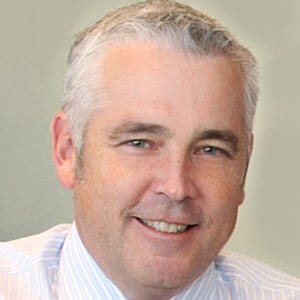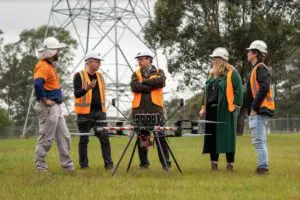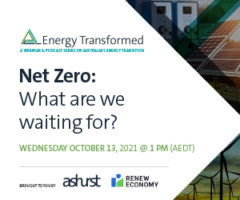Ian McLeod is the head of Ergon Energy, the state-owned network operator and retailer that finds itself at the cutting edge of the energy revolution, thanks to extraordinary area it covers (97 per cent of Queensland), its sparse population, and a huge uptake of rooftop solar.
As part of its Queensland energy special, McLeod agreed to answer 10 questions from RenewEconomy, starting off with how he would build the grid if he had the opportunity to start over with all the technologies and know-how currently available. 
RE: If you were to design the Ergon grid from scratch now, what might it look like?
McLeod: There isn’t one answer that covers our entire grid.
We have 160,000km of network covering a mix of large and small loads, isolated and high-density areas. For instance, take SWER (Single Wire Earth Return transmission lines). We have 65,000km of SWER network, and given the technological advances available today we probably wouldn’t build a complete SWER network like we did in the 1970s and 80s.
Today we would look at hybrid, storage and renewable options, perhaps with some back-up.
In high-density areas, though, there would still be a need for a network linking the major supply and load resources together. The sharing of resources is absolutely critical to achieving the best economic and security outcomes. Building the sort of connectivity we have now would still make sense in high density areas. However, using today’s technology in terms of distributed energy resources, Internet Of Things, big data, situational intelligence and analytics means that less built-in redundancy would be needed.
RE: Given you cannot do that, what is the best means to transition the grid, as it is now, to one best placed for the future.
McLeod: Transition is the operative word, and having an orderly transition is extremely important.
We have to apply the technology where it makes sense and integrate the new technology into the extremities of the network, pull back from the edges, use storage, tariffs and price signals to reduce our spend on network augmentation by sharing and increasing utilisation of available resources.
We need to be conscious of the net economic outcomes. What are the price curves of the new technology? When do we lead and when do we follow? How do we transform the energy ecosystem in the most productive and cost-effective way to achieve key objectives of carbon reduction, affordability, security, employment and economic growth?
Utility-scale renewables can be more efficient than distributed renewables so we need to integrate renewables in a more efficient way. But at the same time we need to maintain choice for customers. We have to ensure that if they want to put a Demand Management System in, if they want to put batteries in, if they want to keep the security of the grid, if they want to put renewables on the roof, then there’s a choice for customers.
But this also needs to be done in an environment without cross-subsidisation and without picking winners in the technology – the market should prevail.

RE: Everyone appears to agree that we are in the midst of an energy revolution, the big question appears to be the speed. What is your take?
McLeod: You have to have an orderly transition. You have to be very clear on what you are trying to achieve and how you will get there in the most efficient and cost-effective way possible. This is what is lacking in Australia.
We have to be cognisant of Australia’s economy. We need to grow Gross Domestic Product, which drives jobs, while achieving our commitments on carbon abatement. Therefore we need an orderly transformation of the energy ecosystem; one that delivers on the above without impacting social equity, affordability and lifestyle.
What we see at the moment is that people are more worried about price and affordability rather than technology. The technology becomes an enabler for peace of mind on price. Yet, it is also a contributor to the price increase. In our busy lives most people generally want to be passive and not worry about electricity and how they use it. We must achieve those objectives.
We need to introduce technology for efficiency and energy productivity, without adding to the supply cost, and we must achieve our carbon goals in the most cost-effective way.
All technologies have a price curve. The cost of digital solutions is now significantly less than physical plant. We’ve seen PV go down quite substantially over a decade and batteries will do the same. So it’s about setting those objectives and determining the most orderly way to achieve them.
RE: Energy storage is seen as the most disruptive technology, but to what extent is it an ally of your network, or a challenge?
McLeod: I see energy storage as less disruptive than solar PV because it can enable us to manage the peaks and troughs.
I see storage as a resource that can be used to assist the network operator reduce its costs and increase utilisation to levels not seen before.
Solar without batteries – and it’s out there on scale with more than 100,000 solar PV units or 25 per cent of stand-alone houses in our patch – is dependent on the sun shining, and that’s not controllable. The consumption taken off the grid has a price impact as well as reliability and quality of supply challenges. But, I see batteries as complementary rather than disruptive. As Elon Musk said at the 2015 Edison Electric Institute Conference: “I don’t think we should disrupt things unless that disruption is going to result in something fundamentally better for society. I’m not really a fan of disruption; I’m a fan of things being better”.
RE: Battery storage is already being implemented in the Ergon network at grid level, and delivering significant savings on maintenance and upgrades. What is the potential here?
McLeod: The immediate commercial value from batteries for us is using them to fix network constraints by changing the load curve.
We’ve got a very peaky load where most of our feeders peak around 6pm when people get home from work and school. At this time the solar is not producing electricity and it is generally being supplied by base load.
So it’s a very dynamic load curve and batteries can certainly assist in fixing that.
Where you are funded to fix a constraint on the network, then using batteries as a lower-cost option to building a bigger network makes sense.
RE: In the past, Ergon has predicted that households, business and some whole communities may go off-grid. How desirable is that, and what role will Ergon play in that transition?
McLeod: It’s very much from a cost perspective for us to try to reduce the overall shared cost to all customers by considering alternative solutions for high-cost connections.
Working on the edge in we can look at our cost to serve and the investments proposed on those networks. And certainly, if a hybrid off-grid solution is better than that in terms of cost we may have a position where there’s a lower-cost option available. However, we must keep the customer in mind. There are some customers who see value in the grid and keeping connected to grid is warranted. We as a utility could have issues in trying to convince some customers to leave the grid because it adds security and possibly property value. A farm or property without grid power may be seen by some in the market as a negative. These are some of the issues we face.
I believe there is an argument for some communities, especially those that are currently not connected, to run smaller micro-grids. Given the technology we have got today, access to alternative energy fuel sources, and the cost of it, there’s potentially a micro-grid solution that could be complementary to the system, it could be connected to a SWER system or it could be completely standalone.
RE: How should technologies such as solar and storage best be rolled out at the consumer level, and what role will tariffs play in helping this?
McLeod: Bringing in that technology should really be about the market enabled by price signals and customer choice. From a network perspective – when it is the least cost option. From a customer perspective, it’s when they see value.
This needs to be market led. Customers generally do not want to worry about energy, and need reassurance that there are stable prices. Those customers who want to reduce their carbon footprint can achieve that with rooftop solar or other Green Scheme products.
As tariffs change to represent the cost of peaks we will see batteries being used to reduce the draw from the grid at peak time and to store solar rooftop generation for use later. So time-of-use tariffs – tariffs that reflect the cost of peak – are very important, and then distributed energy resources can be utilised to reduce the cost to the customer when they reach the right price point. Whether it is demand management or battery storage comes down to whatever option is the best-cost solution to the customer.
From Ergon’s perspective we see ourselves as an open-access platform putting out the price signals to ensure the whole supply chain operates at the most efficient and effective level at the lowest possible price, and encouraging the effective and efficient use of energy within the network. Obviously customers are the key part of that.
RE: What advantages does Ergon have of being a network operator and a retailer in managing this energy transition?
McLeod: We have a unique relationship with our customer, and we can relate a problem to a solution and get the customer to be part of that solution.
The network component, in terms of the overall retail bill, is around 46 per cent. It has come down in this past year because of our capital expenditure reducing, thanks in part to some of the things we have done around demand management. Ergon is enabled to do more demand management because we have a relationship with the customer through our retail business. So where we are constrained and where there are alternative solutions – be it demand management, solar, batteries, or just identifying energy efficiency measures in home energy audits – we are in a much better position to deploy that. We have more intelligence on the constraints, we have got a relationship with the customer and we can relate a problem to a solution and get the customer to be part of that solution. It’s very important to have that linkage through the customer to the actual problems you are trying to solve in the network.
RE: Do you agree with the notion that we can completely decarbonise the grid?
McLeod: In short – it’s technically possible for some grids with nuclear, geothermal and significant water resources but it would be very difficult to do it economically for Australia due to our dry and flat continent.
There might be resources and technology available to achieve this now, but there is not the means to achieve it economically. Obviously sometime in the future there will be lower-cost technology and it will happen. At the moment in regional Queensland we have 25 per cent of detached houses with solar on the roof and they only produce around three per cent of the energy that is consumed from the grid. To achieve security from non-carbon emitting generation you have to integrate storage and over-size the capacity multiple times. That’s where the grid can enable sharing of resources to avoid unnecessary scale.
RE: What do you see as the biggest challenge going forward.
McLeod: What is needed is a sensible debate about our objectives and aspirations. Is it to reduce carbon, while maintaining and improving our lifestyles and achieving sustainable economic growth?
The biggest challenge is getting all parties to agree on a vision for Australia’s energy future, and to agree on objectives that don’t compromise our lifestyle and economic growth. There has to be an economic lens put on this that balances the environmental objectives. The challenge is getting all parties to agree on what the objectives are, what the principles are, what the measures of success are and then come up with a plan to achieve that in the most efficient and cost effective way. There seems to be so much energy wasted as various stakeholders argue for what is best for their part of the industry.
This is part of a series of articles on Queensland sponsored by Norton Rose Fulbright. For the others in the series, please click here and also visit Norton Rose Fulbright’s COP21 coverage.










